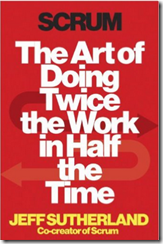The Wright Brothers and Scrum
July 28, 2015 Leave a comment
I recently read two books that, on the cover have nothing to do with each other, but actually have very much similar lessons. The first is David MacCullugh’s The Wright Brothers and Jeff Sutherland’s Scrum: The art of doing twice the work in half the time.
Although the human-interest side of the story was kind of interesting to me, what really stood out was how the Wright brothers got their machine in the air. If you are not familiar with the details of how they constructed the Wright Flyer, there are some pretty interesting points:
1) The Wright brothers were a small agile team that comprised of no fewer than two (the brothers themselves) and no more than seven. I did not realize how important Charlie Taylor and William Tate was to different pieces of the project.
2) The Wright brothers spent the 1st part of their journey doing research, combing all of the scientific literature, and engaging with the current though leaders of the day in a very much open-source style where they would freely share knowledge but retain the final product for themselves. This was in direct contrast to other teams that operated in silos and secrecy.
3) The Wright Brothers believed in doing one thing at a time well. They realized that there were two major problems with heavier than air flight –> thrust and balance. They separated these two concerns and tackled the balance problem first. Once they figured out how to make a glider stable in flight, they then tacked how to add a motor to it.
4) The Wright Brothers made hundreds of small incremental changes with each change able to stand for itself. For example, they went out to Kitty Hawk in the summer of 1900, 1901, and 1902 with gliders before going out the forth time in 1903 with their airplane. Each time, the designs got bigger and closer to the final goal.
5) The Wright brothers were willing to challenge conventional and commonly accepted “facts” when their evidence did not support it. The Wright brothers relied heavily on the calculations of Lilienthal and Chanute to measure lift and drag. After several failed experiments, the Wright brothers ditched those and went with their own, painstakingly researched, measurement tables.
3) The Wright Brothers were in direct competition with Samuel Langley’s airplane. In contrast to the Wright Brother’s agile approach, Langley had a large team that operated in absolutely secrecy while taking massive (at the time) amounts of public funds. When Langley finally rolled out his “final product” it failed miserably every time.
So what does the Wright Brother’s methodology have to do with Scrum? Everything. If you look art the core tenants of Sutherland’s book, most of them can be found in how the Wrights conquered the air. I went though the end of each chapter of Scrum and pulled out some of the take-away points that direct match to how Orville and Wilber did things:
The Wright brothers were doing scrum a full hundred years before it became a thing. As amazing what they created, how they did it is really remarkable. Interestingly for me, the “It’s the journey, not the destination” just rang home. As I write this blog, it is Friday night and I am on my front porch. A neighbor stopped by to say “hello”. When told her I was working on a blog post related to my profession, she said “Oh, I am sorry you are not doing anything fun tonight.” And I said “But this is fun.” and internally I was thinking “I wonder why so many people think work is not fun? Why are some many people socialized that way? I hope my kids don’t wind up like that.”






















